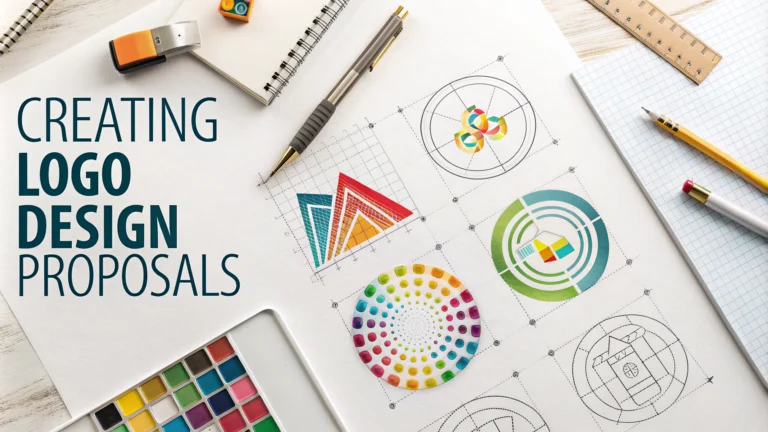A well-designed logo serves as the foundation of your brand’s visual identity.
Planning Your Logo Design
Before starting the design process, gather information about your brand’s values, target audience, and industry competitors.
- Define your brand personality (playful, professional, luxurious, etc.)
- Research your competition’s logos to stand out
- List specific design elements you want to include
- Set a clear budget and timeline
Design Elements to Consider
Each element of your logo should align with your brand message.
| Element | Considerations |
|---|---|
| Colors | 2-3 colors maximum, research color psychology |
| Typography | Choose readable fonts that match brand personality |
| Shapes | Simple geometric forms work best |
Creating Multiple Versions
Design your logo in these essential formats:
- Full color version
- Black and white version
- Reversed (white) version
- Favicon size (16×16 pixels)
Technical Requirements
Save your logo in these file formats:
- AI/EPS: Vector format for printing
- PNG: Web use with transparency
- JPG: Standard web and print use
- SVG: Scalable format for websites
Working with Designers
Professional designers typically charge between $300-$2500 for logo design packages.
Reputable platforms to find logo designers:
Review and Feedback Process
Test your logo designs against these criteria:
- Scalability: readable at all sizes
- Simplicity: recognizable in one glance
- Uniqueness: distinct from competitors
- Versatility: works across all mediums
Legal Considerations
Protect your logo design through these steps:
- Conduct trademark searches
- Register your trademark
- Get proper rights transfer from designer
- Document usage guidelines
Contact the US Patent and Trademark Office at 1-800-786-9199 for trademark registration assistance.
Implementation Strategy
Develop a clear rollout plan for your new logo across all brand touchpoints.
- Create a timeline for updating materials
- Notify stakeholders of the change
- Update digital assets first
- Phase out old materials gradually
Brand Guidelines
Logo Usage Rules
Document specific guidelines for logo implementation:
- Minimum size requirements
- Clear space around logo
- Prohibited modifications
- Placement specifications
Application Examples
| Medium | Requirements |
|---|---|
| Social Media | Square format, high contrast |
| Print Materials | 300 DPI minimum, CMYK color |
| Website | Responsive sizing, SVG format |
Measuring Success
Track these metrics to evaluate logo effectiveness:
- Brand recognition rates
- Customer feedback
- Social media engagement
- Website analytics
Conclusion
A successful logo design requires careful planning, professional execution, and strategic implementation. Regular review and updates ensure your logo remains effective and relevant in representing your brand. Protect your investment through proper legal measures and consistent application across all platforms.
Remember to document all logo versions and guidelines for future reference and maintain brand consistency as your business grows.
FAQs
1. What is the typical turnaround time for a professional logo design?
A professional logo design process typically takes 2-4 weeks, including client consultations, concept development, revisions, and final file delivery.
2. What file formats should I receive with my final logo design?
You should receive multiple file formats including AI (Adobe Illustrator), EPS, SVG, PDF, PNG (with transparent background), and JPG files, in both RGB and CMYK color modes.
3. How much should a professional logo design cost?
Professional logo design costs range from $300 to $2500+ depending on the designer’s experience, complexity of the design, and deliverables included. High-end agencies may charge $5000+.
4. Should my logo design work in black and white?
Yes, your logo must be effective in black and white as it will often be used in monochrome applications like faxes, stamps, or single-color printing.
5. What makes a logo design timeless?
Timeless logos feature simple, memorable designs, avoid trendy effects, use classic typography, and focus on clear brand communication rather than decorative elements.
6. How many logo concepts should a designer present?
Professional designers typically present 3-5 unique concepts in the first round, allowing clients to choose a direction while maintaining design quality and avoiding overwhelm.
7. What’s the difference between a logo and a brand identity?
A logo is a single visual mark representing your business, while brand identity includes the complete visual system: logos, colors, typography, imagery, and design guidelines.
8. Can I trademark my logo design?
Yes, unique logos can be trademarked. However, the logo must be original, distinctive, and used in commerce to qualify for trademark protection.
9. Should my logo be responsive for different platforms?
Yes, modern logos should have responsive variations that adapt to different sizes and platforms, from large billboards to small social media icons.
10. What information does a designer need to create an effective logo?
Designers need your business name, industry, target audience, brand values, preferred styles, competitors, intended logo applications, and any specific requirements or restrictions.








